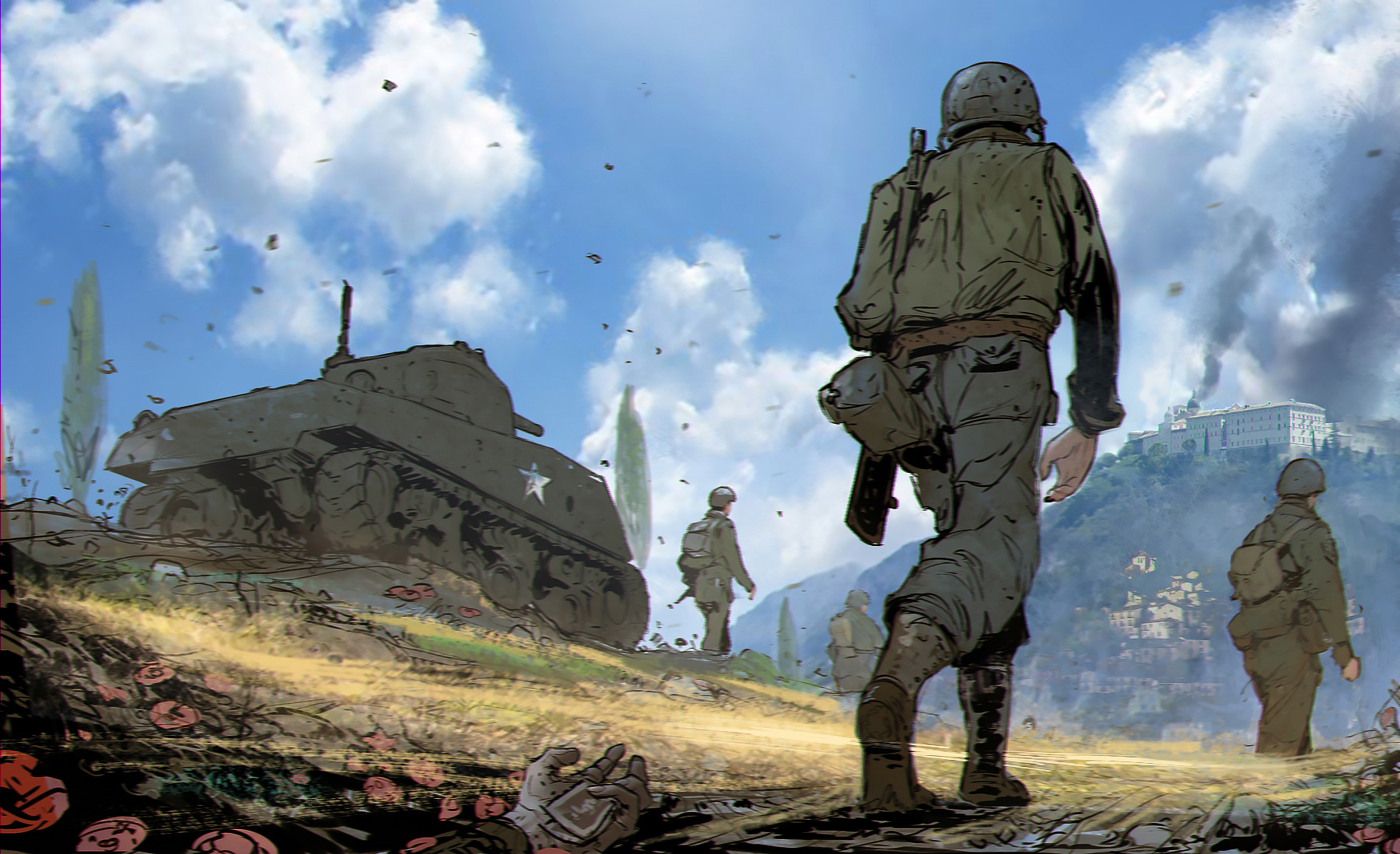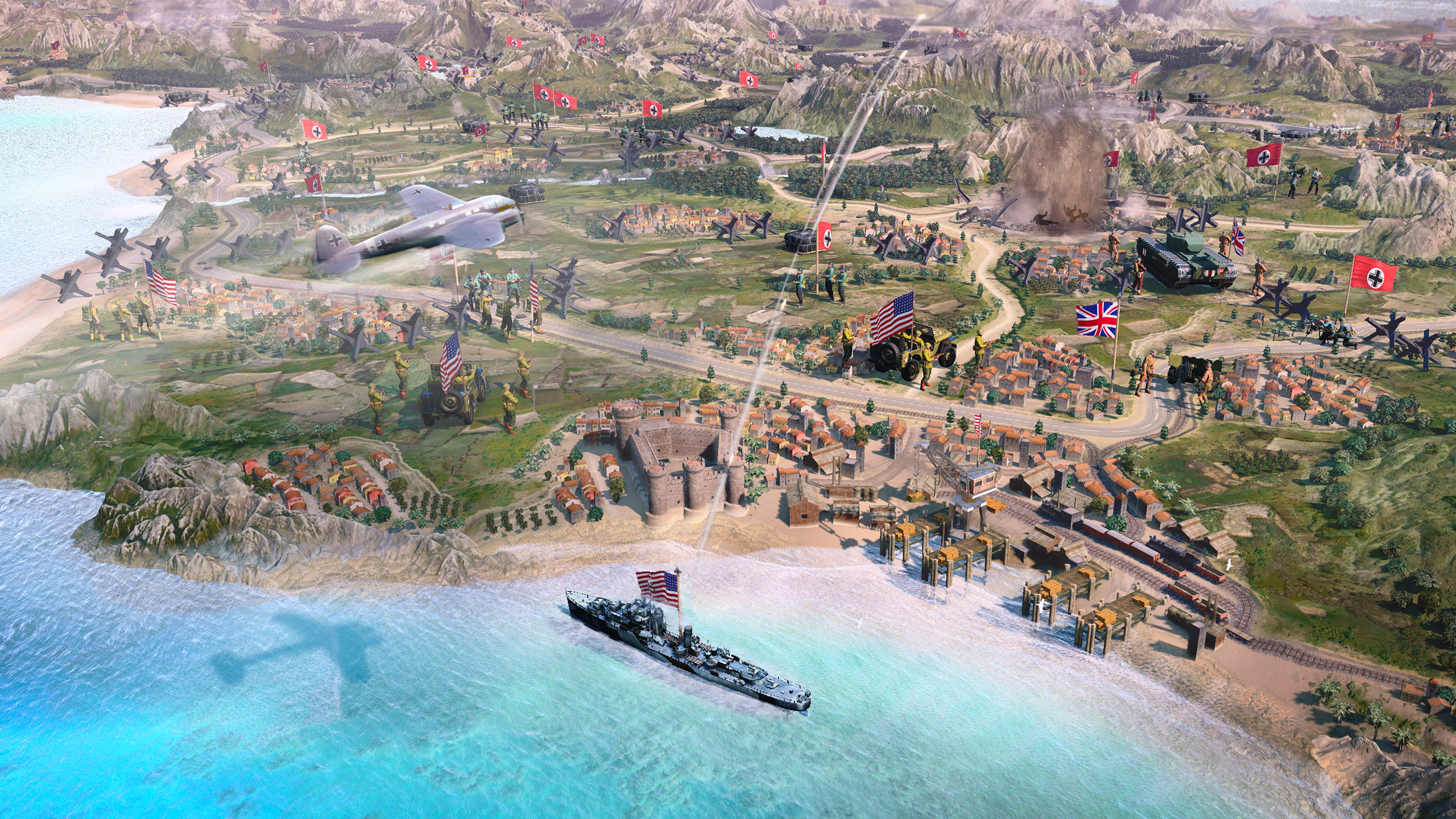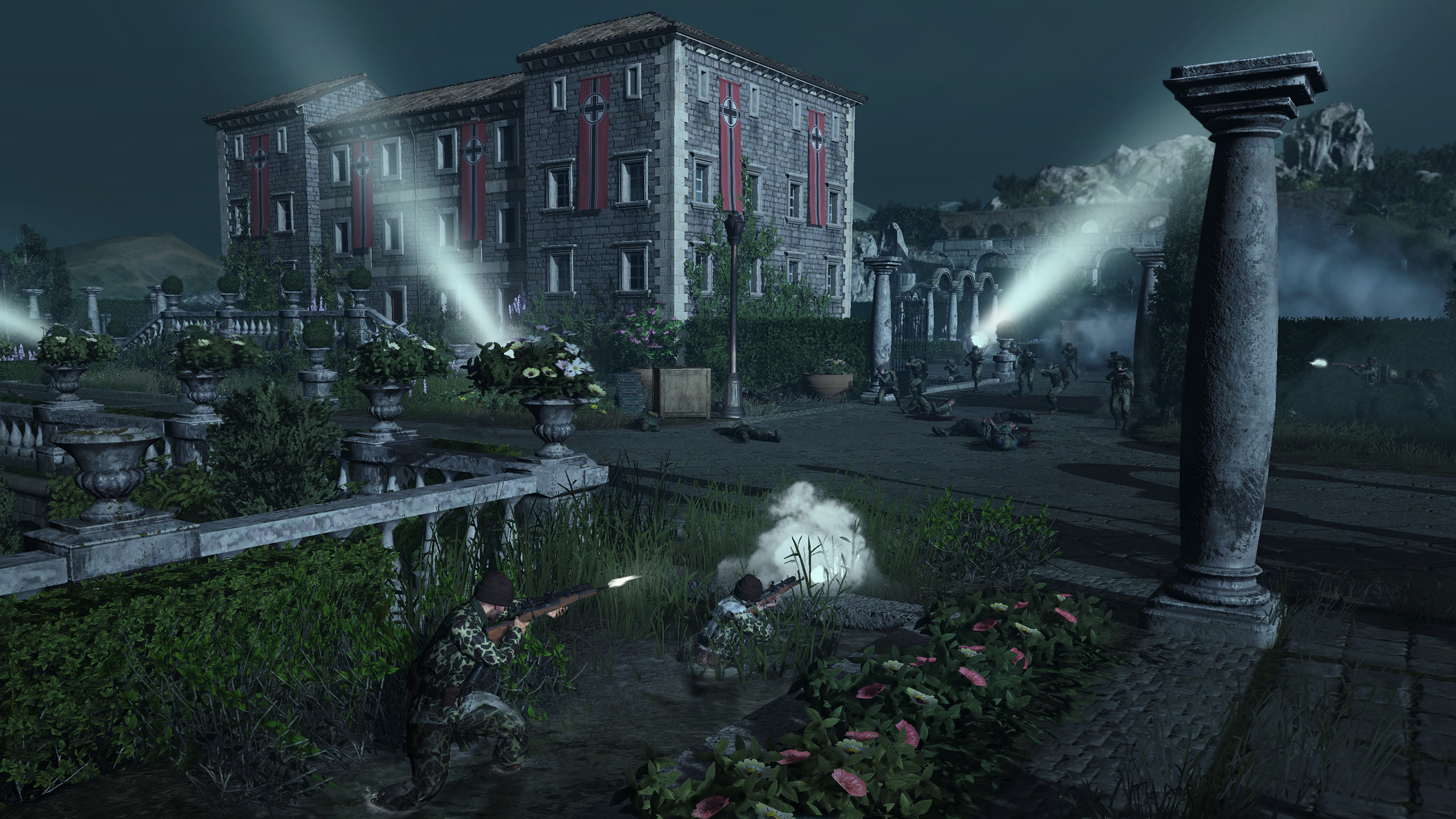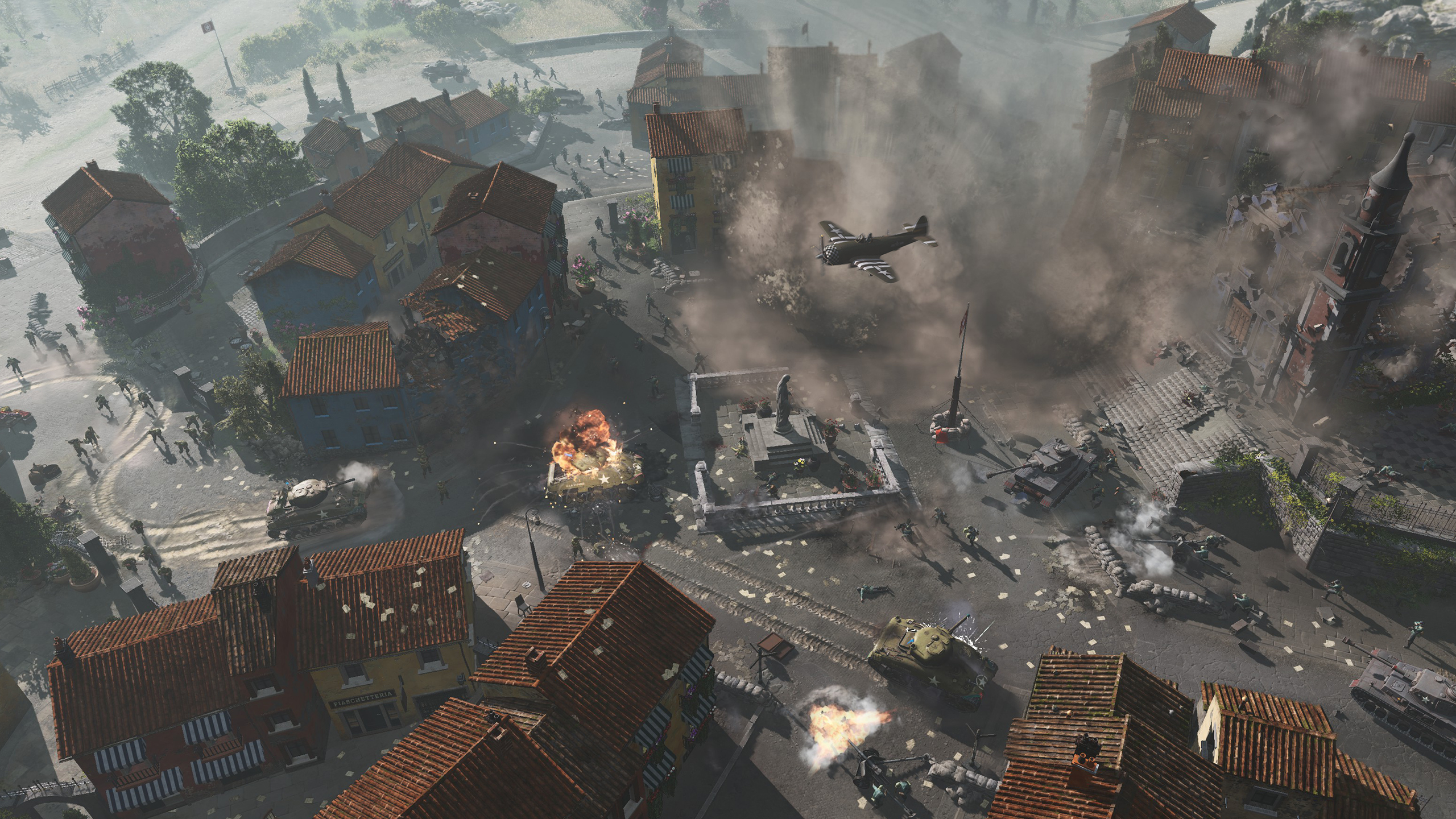Company of Heroes 3 is a World War 2 sandbox with the scale of Total War
Hands-on with Relic's massive RTS.

Company of Heroes with the scale of Total War sounds like the sort of fanciful combination that you might daydream about without ever expecting it to happen. Well, I've got good news for you—Company of Heroes 3 is very real. The bombastic real-time brawls the series is known for return, but this time they're spread across a dynamic, turn-based campaign full of skirmishes, optional objectives and territory to fight over.
One glimpse at a battle and this is unmistakably Company of Heroes, but at every turn there's a transformative new addition. You'll be able to control both US and UK forces across the campaign, including their navies and air forces, dramatically beefing up your list of strategic options. You can plan amphibious landings, drop paratroopers behind enemy lines and annihilate enemies with your naval artillery. In the real-time fights, there's a new destruction system, more deadly tools to play with and a very surprising tactical pause system.
Team up
This ambitious chimera has been in the works for a while. Taking a leaf out of fellow Sega studio Amplitude's book, it's using the Games2Gether platform to leverage the series' community, and for three years there's been a player council offering feedback. They've already had a significant impact, it seems, and they're one of the reasons Company of Heroes 3 is set in Italy and North Africa instead of another theatre, like the Pacific.

The slice I'm playing begins in medias res, following the arrival of US and UK forces in Italy. There's already been some fighting, and I'm given one of three different approaches to select, determining what forces I get to control at the start. I have to begin in Naples, but eventually there will be other choices for starting locations. I want all the toys, naturally, so I go for the option that lets me command a mix of US and UK forces. I've got one big goal: take the indomitable Monte Cassino, opening up a way to Rome. First, though, I've got a lot of fighting and liberating to do.
While Relic has dabbled in dynamic campaigns before, like the excellent Ardennes Assault standalone expansion, these campaigns played second fiddle to the RTS action—not so in Company of Heroes 3. Both layers share the spotlight, fundamentally interconnected. Nearly everything you can do in the RTS layer can be replicated in the turn-based campaign, whether it's bombarding the enemy with artillery strikes or plonking down some nasty mines in the middle of the road.
The daunting number of systems and possibilities is made a lot more intuitive because of this strong connection between the campaign and real-time battles. There's a level of consistency and permanence that even Total War hasn't achieved yet, and a sense that whatever you're doing is going to have an impact on both the map and the battlefields.

With my army in Naples, the sprawling Italian countryside stretches out before them. It's a chunky map, but only a small slice of the full Italian campaign map that we'll get to play at launch. Each discrete bit of territory offers something, whether it's more resources, another link in the supply chain—if the chain breaks, your cut-off units won't be at peak efficiency—or access to air and naval forces. You don't need to take every town in Italy, but I quickly found myself being seduced by the promise of total conquest and all the goodies that come with it.
Keep up to date with the most important stories and the best deals, as picked by the PC Gamer team.
It's a fetching map, too, with lots of little cosmetic flourishes, like the Vesuvius standing next to Pompeii, huge and menacing, or the striking Monte Cassino, which looks lovely even when it's surrounded by barricades, tanks and AA guns. But Relic's also built it with an eye towards logistics and authenticity. Relic used old maps made by the Royal Engineers to see where rail lines and roads were, which ones were functional, which ones could be used by tanks, so that journey through Italy, the routes you take and the obstacles in your way, are authentic to what that environment was at the time.
A-Team
After spending a bit of time admiring Italy, I get back to the war. My first target is the nearest airbase, giving me access to handy things like aerial reconnaissance and paratrooper drops. Before storming the airbase, however, I have to decide my approach and pick my troops.

I've got several companies and detachments at my disposal, and how I combine them will have a big impact on the battle ahead. Companies are your primary units that you'll use to engage the enemy in real-time battles, from American airborne units to the devastating Indian artillery. Across the war, they get points that can be spent on a variety of upgrades allowing you to both empower and specialise them. They're backed up by detachments, which can still march across the map independent of the companies, taking territory and getting into turn-based fights. They can't actually instigate real-time battles on their own, however, but if they are near or attached to a company when one starts, they can provide a range of benefits.
Being a cautious commander, I decide to bring a medical detachment with me for the airbase mission. On the campaign map, this detachment can heal my infantry, and in missions this translates to a very helpful little truck that passively heals any troops standing near it. The truck can be destroyed, of course, and I turn protecting it into a personal side mission. Battles also conjure up explicit optional objectives, like finding intel or taking out a specific enemy.
The medical truck proves to be a significant boon, especially given that it's been a while since I played Company of Heroes. As helpful as it is, though, it pales in comparison to the tactical pause feature. My reflexes ain't what they used to be, so the ability to pause the action at any time to issue commands and create waypoints is a genuine lifesaver, especially when I split my forces up and find myself managing multiple battles. I consider myself an experienced, if lapsed, player, but I see myself continuing to use the tactical pause quite a bit. It's just endlessly satisfying to put together a plan and then go back to the action and see my lads pull off a perfectly-timed tactical manoeuver. It's only available in singleplayer, though, so if you're planning on getting stuck into the PvP you won't want to rely on it too much.

My first Company of Heroes 3 mission is a delight—a dramatic battle lit up by countless fires and explosions, courtesy of the airbase's many, many fuel-filled barrels. At one point, I have to charge across empty runways, using the occasional ditch to hide my troops, and when one isn't available, my poor medical truck. In the north, by the hangars, other soldiers duke it out with entrenched Nazis as buildings are blown to smithereens. They get pinned down by a sniper in a tower, but smoke grenades and rockets make short work of it. Amid the fracas, I'm plonking down new buildings near my HQ, recruiting units, and upgrading my existing ones as they tier up. When my engineers get flamethrowers, that's when we really start cooking. There's so much going on that I forget all about the intel, but I still manage to take the airbase, giving me another tool to make my march north, to Monte Cassino, just a little bit easier.
Nearly everything you can do in the RTS layer can be replicated in the turn-based campaign.
The level of destruction has always been one of the things that's made Company of Heroes stand out, so naturally Relic has given a lot of attention to the system. Relic's artists have worked tirelessly to build stunning Italian villages that you won't be able to stop yourself from mercilessly destroying. I feel a wee bit guilty seeing these picturesque locales reduced to rubble and craters, but the destruction system is just a joy to behold.
Every projectile feels tangible and deadly when it's pounding walls to dust, and there's a grim beauty to all the devastation. Sometimes it feels like you're building a warzone rather than destroying a town. And objects don't just have two states—they aren't simply standing or destroyed. The system is gradual and modular, telling the story of how things were blown up. And it affects everything, from foliage to tanks, though it's obviously most notable when a building is taking a beating. There have been practical improvements, too, so now fallen masonry can be used as cover, and Relic's fiddling around with a system where soldiers might get crushed, or dodge out of the way, when it falls. And if the thought of all these demolished buildings is making you feel sad, you can mitigate some of the destruction by using the new breach system to get enemies out of buildings instead of levelling them. Drop a smoke grenade and then tell your troops to run to the door and they can toss in a grenade and rush the enemy, or better yet, fill the interior with fire from a flamethrower. Enemies will try to flee, but that's why you stick some troops at the back.

Emboldened by my first victory, I step into my second fight with a confident swagger. I've bumped into an enemy company, kicking off a random skirmish. Only a couple of skirmish maps are available in this build, though the changing forces and objectives mean that, even after two days of playing, I'm still enjoying them. My first skirmish, though, doesn't quite go as planned. My enemy and I begin at opposite ends of the map and we're tasked with simply taking territory, in particular a trio of victory points. Unfortunately, I underestimate the speed of my foe's advance and sadly find myself stuck fighting over one victory point as a relentless tide of Germans assault it. They win.
Second chances
If this had been Company of Heroes 1 or 2, that would have been it for me, but in this World War 2 sandbox I have to live with my failure—and that also gives me a chance for revenge. While my company takes some damage, it survives, and the enemy gains no ground. In fact, it's actually taken more damage. It might have won the skirmish, but it was a Pyrrhic victory. It's also possible to completely destroy an enemy company or attachment before the battle begins. Units can exchange fire once-per-turn on the campaign map, and artillery strikes from your companies or naval support can make fast work of them, saving time and the lives of your troops.
Plenty more skirmishes will accompany the bespoke missions at launch. As an unrepentant turtler, I'm especially happy to hear that proper defensive missions will be in the mix, giving you time to set up your fortifications and lay traps. And then there are the more unusual modes, like skirmishes where you need to route and then chase them so nobody can escape. Brutal. There's still time for the team to explore more skirmish themes, too, and they seem eager to experiment. Ideas like bridge battles get thrown around, and I suspect that once more players start testing and throwing their feedback into the pile we'll see that list of possibilities grow.

As I get to work liberating Italy, some chums chime in. I've got a trio of advisors, representing the British, US and Italian partisan forces. These characters give the war a face, along with potential upgrade paths, ethical conundrums and some internal tension. The most interesting among them might be the partisan advisor, who reflects the civilian contributions to the war, and their toll. When my American bud tells me to bomb Monte Cassino, to make our assault easier, his partisan counterpart warns that there might be civilians hiding within the building we're targeting, advising me to send in partisans first to make sure. Picking a path doesn't always mean the other ones suddenly disappear, and you can try to keep everyone happy, but there will be some occasions where you have to pick a side.
The Nazis aren't faceless adversaries, either. Enemy commanders will have AI personalities that inform their tactics, and may react differently depending on the situation—a commander on the edge of obliteration with seemingly nothing to lose might become ultra aggressive and make you fight harder for every kill. Personality traits might be invisible initially, but befriending partisans allows you to send them on information gathering missions, among others, giving you the lowdown on a foe.
During my march north, I get alerted to the presence of a special named opponent and nemesis of the partisans, General Taube, leading to a hunt for this deadly tank commander. There are various locations where he might be hiding, but through a separate side mission I'm able to uncover intel that narrows it down. Our first and final meeting takes place in a real-time tank brawl around a small town, culminating in what almost feels like a boss battle, his intimidating Tiger II heavy tank against my considerably more vulnerable troops. I lay traps, hide my soldiers everywhere, set up killzones where anything wandering into them will immediately be blown to smithereens, and nothing goes according to plan. It's a glorious mess. I take him out, but the town is dust.

With Taube's defeat, I feel like I can probably take Monte Cassino. I've already liberated most of this part of Italy, and that's the last big challenge left. Since I opted to not bomb the place, the Germans are well fortified and waiting for me, but at least they don't have any backup from Taube and his tanks. It's a large map, dominated by a huge hill and one main road, which the enemy forces are obviously keeping a close eye on. Knowing they'll be light on tanks, however, I strike with an armoured company, and it proves to be the right call. The journey up that mountain is slow and painful, and at the top I notice I have absolutely no infantry left. What I do have, however, is five Churchill tanks, and boy do we have some fun. The picturesque setting is turned into craters and rubble, quite a lot of it thanks to me, but I can't feel sad. I've taken Monte Cassino.
Relic estimates that it should take around four hours to complete the slice I was fighting through. I played for 11. There were some known bugs and performance issues slowing me down towards the end, but I really spent so long in Italy because I didn't want to finish the war. There was always one more skirmish waiting for me, one more region needing to be liberated, another system demanding to be experimented with. And since then, I've been waiting impatiently to return. Thankfully, despite the 2022 release date, it's playable right now. A pre-alpha demo is available on Steam, and you can blow up tanks and breach buildings with flamethrowers until 7 pm PDT on August 2/3 am BST on August 3.

Fraser is the UK online editor and has actually met The Internet in person. With over a decade of experience, he's been around the block a few times, serving as a freelancer, news editor and prolific reviewer. Strategy games have been a 30-year-long obsession, from tiny RTSs to sprawling political sims, and he never turns down the chance to rave about Total War or Crusader Kings. He's also been known to set up shop in the latest MMO and likes to wind down with an endlessly deep, systemic RPG. These days, when he's not editing, he can usually be found writing features that are 1,000 words too long or talking about his dog.

